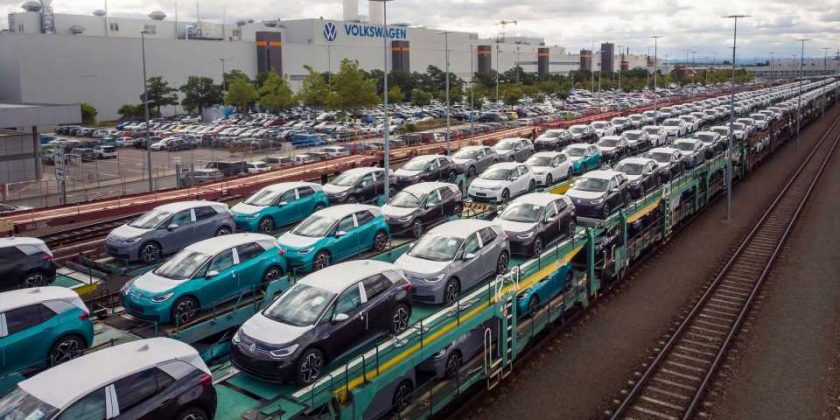An Autocar op-ed says the ID.3 may be too late, but what about massive production numbers?
In September 2019, we published an article comparing the VW ID.3 with the Renault K-ZE to check which one would be the EV for the masses. At that point, we still did not realize something an article at Autocar reminded us of: the electric Volkswagen is neither the cheapest nor the more efficient EV on the market. It also does not lead in terms of technology. How, then, will VW make it become the electric Beetle? The answer to that is scale.
It took us the start of deliveries for the ID.3, the presentation of the ID.4, and the first documented accidents with the electric Volkswagen to realize the German company’s plan, even if the German automaker had anticipated it more than once.

Just as a reminder, Volkswagen said it intended to produce 1 million EVs by 2022. Mind you that the goal is not to achieve that many electric cars by then. VW’s target is to deliver 1 million per year in two years and a lot more in the future.
It took Tesla 17 years to get to that number, reached with a Model Y on March 10, 2020. That proves companies that already know how to build vehicles for many decades do not have only hindrances in their path towards electrification. They have aces in the hole that can be crucial. By 2028, Volkswagen expects to have produced 22 million EVs.
That shows the company counts on its skills about manufacturing to change the game in its favor. Elon Musk himself is praising manufacturing more and more because “building the machine that makes the machine” is a lot harder than building the machine itself.
When Volkswagen started delivering the ID.3 in Europe, it made a ceremony to handle the first one to Oliver Nicolai on September 11. Still, the cars were already in Norway, UK, Sweden, Belgium, Ireland, Italy, and the Netherlands. They were probably in all European markets, but we cannot tell that for sure.

Forget about Europe and think about the US. The ID.4 is not produced there yet, and Volkswagen already promised to sell it in all 50 states. Not even Tesla does that, mostly because it is not allowed to sell directly to customers in many of them – including Texas.
Now think about China. A tweet from Stultus shows GM has sold more EVs in China than Tesla in September 2020. Volkswagen is the biggest carmaker there. When it starts delivering electric cars in the biggest car market in the world, what do you expect to happen? Think about it.
Finally, we have the first accidents with the ID.3. All of them happened due to human errors and during test drives, involving people of different age groups. As we wrote in that article, that is a sign the ID.3 may be more popular than sales numbers can tell at this point. At least if buyers do not have the same impression Auto Motor Und Sport had when testing one.

Above cutting-edge technology or anything else, people craving to swap their ICE cars for electric ones want to feel safe about the change. They want to know they will be able to easily service their vehicles or have them recalled as fast as possible should any safety concern emerge. Established companies may offer that with less effort than new ones. Unlike what some may think, people do not want to buy prototype cars: they want a trouble-free experience.
The deal for these legacy automakers will be to supply the demand competently. If customers know they can visit a dealership and order their EVs without having to wait, why won’t they? That’s what they are used to have nowadays with combustion-engined cars.

Although the Renault K-ZE offers a low price, most families in Europe will deem it a small car when sold there as the Dacia Spring. The ID.3 has the right size for their needs, and it may replace the VW Golf in their preferences. In other words, it will cannibalize sales of VW’s best-seller in the Old Continent, but that’s the idea. If the price were all that mattered, the Tata Nano would have been a world success.
Volkswagen may bet the ID.3 will be its next Beetle or Golf, but that does not mean it puts its money on the “one-size-fits-all” approach. It’s right the opposite: it knows which sort of vehicle sells best for each of its most strategic markets.
The ID.3 is meant for Europe and countries that are still fond of hatchbacks – very few if you ask us. Its ID family car for the US and China is the ID.4, which may be too big for Europe and Latin America, for example. Regardless, in terms of sale volumes, the electric CUV is probably the rightful Beetle successor.
What matters for Volkswagen is being able to sell the ID.3 – or the ID.4 – where people want to buy it, in any of its thousands of dealerships around the world. Produced on a large scale, in multiple factories, it will eventually cost less. While it doesn’t, government subsidies will do the trick.
Summing up, all concerns about range, price, or charging regarding the ID.3 may not compete with “when and where do I get one?” If that question is answered in the way consumers want (now and near, respectively), the ID.3 may be exactly the opportunity VW wanted and planned for. Sales will tell.
Source: Autocar
Source: Read Full Article
